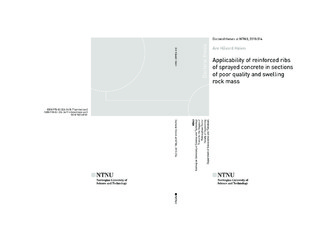| dc.contributor.advisor | Nilsen, Bjørn | |
| dc.contributor.advisor | Olsson, Roger | |
| dc.contributor.author | Høien, Are Håvard | |
| dc.date.accessioned | 2019-02-06T14:32:05Z | |
| dc.date.available | 2019-02-06T14:32:05Z | |
| dc.date.issued | 2018 | |
| dc.identifier.isbn | 978-82-326-3419-4 | |
| dc.identifier.issn | 1503-8181 | |
| dc.identifier.uri | http://hdl.handle.net/11250/2584189 | |
| dc.description.abstract | When excavating tunnels, reinforcement and support is required depending on the quality of the rock mass. In good quality rock mass, simple reinforcement such as sprayed concrete and rock bolts is usually adequate as support. In areas with very weak rock mass and unfavourable stresses, more comprehensive support methods need to be applied to avoid large deformations in the rock mass. In Norwegian hard rock tunnelling, the geology is characterised mostly by hard rock intersected by weakness zones that often contain swelling minerals. The common rock support in such weakness zones is rebar reinforced ribs of sprayed concrete (RRS) combined with rock bolts and reinforced sprayed concrete between the ribs. This practice is mostly based on experience and the scientific basis to support the practise and its best application is limited.
The main objective of this thesis was to explore deformations in sections of weak rock in hard rock tunnels, with the purpose of developing a better understanding of the use of RRS in tunnelling. A special focus have been placed on how swelling minerals may affect the system. This has been achieved by performing full-scale in-situ monitoring, laboratory testing, numerical modelling and collection and systemization of existing data.
Field monitoring of RRS in Norwegian road tunnels has shown only small deformations in the rock mass and no substantial strain in the rebar of the RRS. When evaluating the field measurements based on numerical modelling, it has been found that the RRS have not been subjected to any load, and hence have had no load-bearing function.
By comparing data from a parameter study based on numerical modelling with data extracted from The Norwegian Public Roads Administration (NPRA) tunnel data base, it was discovered that that RRS has been applied in tunnels where the conditions probably would not require load-bearing support. In the literature, a convergence of 1% is suggested as the limit for the rock to require load-bearing support. This implies that there is an interval where the need for rock support exceeds bolts and sprayed concrete, but where load-bearing support is too extensive.
To explore how swelling minerals may affect the support construction, reconstituted cores of swelling gouge have been tested triaxially. The registered deformation was found to be dominated by creep in the material and no swelling was observed during the saturation of the initially dry specimens. This implies that swelling was insignificant compared to other deformation processes, but as the deformation rate increased during saturation, it may have accelerated the creep process.
Oedometer testing on the swelling gouge with different initial water contents was conducted on the fraction < 20 µm. The behaviour of the material suggests that one could find the water content for where the intracrystalline swelling ends and the osmotic swelling begins. This is important since the rock stress in many cases exceeds the osmotic swelling stress, while it will not exceed the intracrystalline swelling stress. Related to in-situ gouge, one may thus be able to predict whether the material will swell if exposed to water or if the rock stress may force water out, making it shrink. The oedometer testing also showed that the swelling pressure was dependent on the density of the material.
The results described above imply that the current design of the RRS is in most cases over-dimensioned and that a leaner design, which is not load-bearing, is probably sufficient for most cases. Earlier, reinforced but unarched RRS was used, which require less material (steel, concrete) compared to the load-bearing arched RRS used today. By performing surveillance of the deformations based on total stations, the use of unarched RRS could be safely implemented, first at a project level and later, when having more data, on a systematic level. As part of implementing such a leaner RRS, it is important that effort is also devoted to characterizing the weakness zones and identifying the most important parameters of their deformability. | nb_NO |
| dc.language.iso | eng | nb_NO |
| dc.publisher | NTNU | nb_NO |
| dc.relation.ispartofseries | Doctoral theses at NTNU;2018:314 | |
| dc.relation.haspart | Paper 1:
Høien, Are Håvard; Nilsen, Bjørn.
Analysis of the stabilising effect of ribs of reinforced sprayed concrete(RRS) in the Løren road tunnel. Bulletin of Engineering Geology and the Environment 2019 ;Volum 78.(3) s. 1777-1793
This is an open access article distributed under the terms of the Creative Commons CC BY license (Attribution
CC BY )
https://doi.org/10.1007/s10064-018-1238-1 | |
| dc.relation.haspart | Paper 2:
Høien, Are Håvard; Nilsen, Bjørn; Olsson, Roger.
Main aspects of deformation and rock support in Norwegian road tunnels. Tunnelling and Underground Space Technology 2019 ;Volum 86. s. 262-278
- Published under a Creative Commens license
Attribution 4.0 International (CC BY 4.0)
https://doi.org/10.1016/j.tust.2019.01.026 | |
| dc.relation.haspart | Paper 3:
Høien, Are Håvard; Nilsen, Bjørn; Vistnes, Gunnar; Olsson, Roger.
Experimental triaxial testing of swelling gouge materials. Bulletin of Engineering Geology and the Environment 2019 s. 1-16
- This is an open access article distributed under the terms of the Creative Commons CC BY license (Attribution
CC BY )
https://doi.org/10.1007/s10064-019-01547-6 | |
| dc.relation.haspart | Paper 4:
Høien, Are Håvard; Nilsen, Bjørn; Olsson, Roger.
Oedometer testing of swelling gouge materials at different water contents. I: Rock Mechanics for Natural Resources and Infrastructure Development. CRC Press 2019 s. 1769-1782
https://doi.org/10.1201/9780367823177 | |
| dc.title | Applicability of Reinforced Ribs om Sprayed Concrete in Sections of Poor Quality and Swelling Rock Mass | nb_NO |
| dc.type | Doctoral thesis | nb_NO |
| dc.subject.nsi | VDP::Technology: 500::Rock and petroleum disciplines: 510::Geological engineering: 513 | nb_NO |
